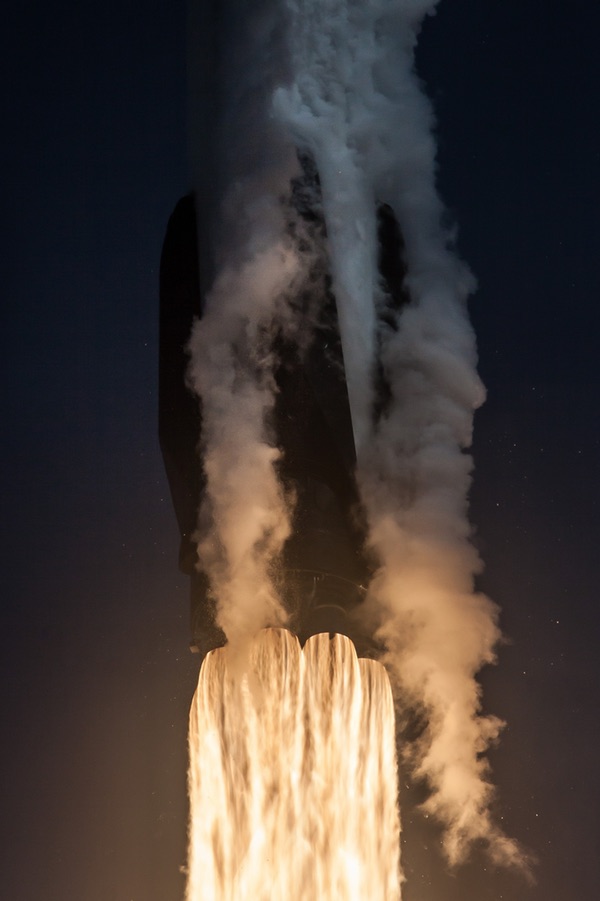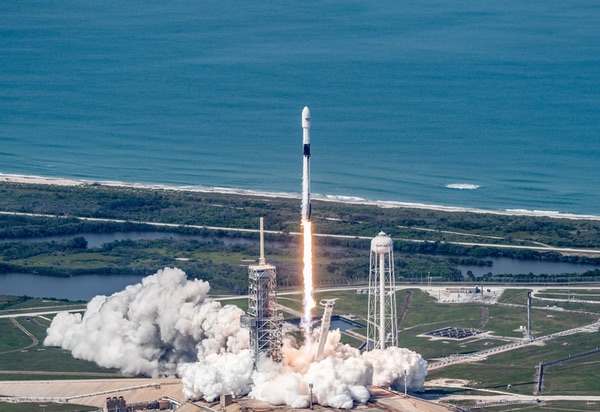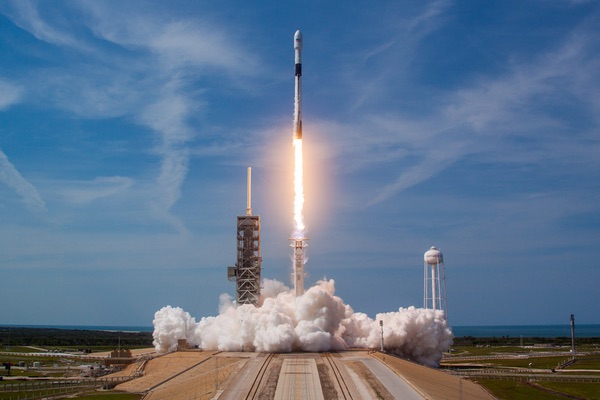SpaceX’s workhorse rocket takes flightby Jeff Foust
|
| “I think truly remarkable to launch an orbit-class rocket—the same orbital-class rocket—twice in one day,” Musk said. |
The problem, it turned out, was not a flaw with the vehicle itself. Instead, the company said at the beginning of its broadcast of the second launch attempt the next day, an “artifact of an earlier test sequence” involving a ground system triggered the hold. This time, there were no last-minute issues, and the rocket lifted off at the beginning of its launch window, successfully placing a French-built communications satellite for Bangladesh into geostationary transfer orbit less than 35 minutes later.
At first glance, that Falcon 9 looked little different from the previous versions of the rocket. Its interstage section between the first and second stages was now black, as were the four landing legs at the base of the first stage. Those superficial aesthetic differences, though, hid more substantive changes to the vehicle in the company’s quest to make it more reliable and more reusable.
In a conference call with reporters shortly before the scrubbed launch attempt Thursday, SpaceX CEO and founder Elon Musk said that this “Block 5” version of the rocket is really the sixth version of the rocket. “Because we had version one; version 1.1, which was really like version 2; arguably a version in between that; and then a bunch of blocks,” he said.
Whether you call it Block 5 or Version 6, Musk said a major change in the vehicle was an emphasis on rapid reusability. “The key to Block 5 is that it’s designed to do ten or more flights with no refurbishment between each flight, or at least no scheduled refurbishment between each flight,” he said. “The only thing that needs to change is you reload propellant and fly again.”
SpaceX already demonstrated reusability with the previous Block 4 version of the rocket, with 11 reflown first stages launched to date. However, the Block 4 version required more maintenance between flights, and were only being flown a couple of times. “With Block 4, we’d optimized it to probably about a week’s worth of refurbishments if pushed. Maybe, call it about ten days of work between flights,” he said. But Block 5 is “really better in every way than Block 4.”
How much better? The no-refurbishment goal of the Block 5 first stage means it is at least theoretically feasible to fly it twice within 24 hours, and Musk has set a goal to do just that later next year.
“So it’s going to take some amount of time—we’re going to be very careful and deliberate about this—but that will be I think truly remarkable, to launch an orbit-class rocket—the same orbital-class rocket—twice in one day,” he said.
He didn’t provide additional details about how that would be carried out, but the company faces challenges beyond just rapidly reusing the booster. Presumably, the first launch would be for a payload light enough to enable the stage to return to land, where it would be lowered to the horizontal position and trucked back to a processing facility where it can be fitted with a new upper stage and payload and taken to the pad for another launch attempt.
| “Would you rather fly in an aircraft that’s never had a test flight before, or would you rather fly in an aircraft that’s flown many times successfully?” |
That assumes that the pad itself can be turned around in less than 24 hours, but SpaceX get around that by doing one launch from Launch Complex 39A and the other from Space Launch Complex 40, several kilometers away at Cape Canaveral. The Eastern Range would have to be able to support that fast of a turnaround, although the Air Force has stated one goal for its “Drive for 48” range upgrade is to be able to handle two launches in 24 hours (it was prepared to do so earlier this year for Falcon 9 and Atlas 5 launches.) Also, the payloads have to be available and processed in parallel to support the back-to-back launches.
That goal, though, appears primarily to demonstrate that the Block 5 first stages can be reused frequently, and last a long time. “There’ll be some moderate scheduled maintenance at ten [flights], but we believe that the Block 5 boosters are capable of on the order of at least a hundred flights before being retired, maybe more,” Musk said.
Musk said he expected that customers, once reticent to fly on previously-flown boosters, will soon come to prefer them. “I think the general sentiment will change from feeling like a flown rocket is scary to feeling like an un-flown rocket is scary,” he said. “Would you rather fly in an aircraft that’s never had a test flight before, or would you rather fly in an aircraft that’s flown many times successfully?”
With that kind of reusability, Musk said he anticipates building just 30 to 50 Block 5 first stages, even though he expects the vehicle to perform at least 300 launches before being retired in favor of the company’s BFR (officially, Big Falcon Rocket).
 A closeup of the Falcon 9 first stage on the first Block 5 launch. (credit: SpaceX) |
Reliability and human spaceflight
Another key motivator for the Block 5 upgrade, Musk said, was reliability. The Block 5 will be used for launching commercial crew missions for NASA—Friday’s launch was the first of seven launches of the new vehicle required before NASA will allow it to be used for crewed missions—as well as for national security missions for the Air Force.
“We need to exceed all of NASA’s human-rating requirements for Block 5, and they are quite extensive, as well as meet all of the Air Force requirements for extreme reliability,” he said. “I really don’t want to jinx fate here, but this rocket is really designed to be—the intent is to be—the most reliable rocket ever built. That is the design intent. I hope fate does not punish me for these words, but that is unequivocally the intent.”
Among those changes is a redesign of the composite-overwrapped pressure vessels (COPVs) used to store helium in the upper stage propellant tanks to pressurize them. The failure of one COPV caused a Falcon 9 second stage to explode during preparations for a static-fire test in 2016, while another, coming loose from a strut that broke at loads lower than it was rated for, led to the failure of another during a 2015 launch, the only two Falcon 9 failures to date.
Redesigning the COPV was critical for enabling the Falcon 9 to carry crews. A report by NASA’s Aerospace Safety Advisory Panel earlier this year suggested that more COPV testing was needed before allowing crewed launches. “In our opinion, adequate understanding of the COPV behavior in cryogenic oxygen is an absolutely essential precursor to potential certification for human space flight,” it stated in its annual report.
“Man, we have tested the living daylights out of those things, 17 ways to Sunday,” Musk said of the redesigned COPVs. The new COPV is the “most advanced pressure vessel ever developed by humanity,” he said later in the call. “I’ve personally gone over the test design, I’ve lost count how many times. But the top engineering minds at SpaceX have agonized over this. We’ve tested the living daylights out of it.”
| “The reason it’s so hard to make an orbital rocket work is that your passing grade is 100 percent, and you can’t fully and properly test an orbital rocket until it launches.” |
NASA panels have also raised questions about the so-called “load-and-go” process of fueling the Falcon 9 shortly before flight—propellants are loaded starting less than 40 minutes before liftoff—and after astronauts have boarded the Crew Dragon spacecraft. Some, like former astronaut Tom Stafford, chair of the NASA’s ISS Advisory Committee, have criticized that approach as going against a half-century of experience in human spaceflight operations, where fueling is done prior to crews boarding the vehicle.
Musk downplayed those concerns as “somewhat overblown” in the call. “We certainly could load the propellant and then have the astronauts board Dragon. That’s certainly something we could do,” he said. “But I don’t think it’s going to be necessary, any more than passengers on an aircraft need to wait until the aircraft is fully fueled before boarding.”
For much of the call, which lasted for more than 45 minutes, Musk went into deep detail about the various changes to the Block 5 version of the Falcon 9, from the strengthening of the “octaweb” structure that holds the nine Merlin engines in the first stage to the use of titanium, rather than aluminum, grid fins to control the first stage on its descent. “I’m giving a lot of technical information and hopefully this is interesting, but I’m happy to answer any detailed technical questions you may have as well, following this, within the bounds of ITAR constraints,” he said at one point.
But Musk also sounded a little stressed about the launch. “You know, it could be a thousand things that go right on this rocket, and one that goes wrong, and a passing grade for rockets—the reason it’s so hard to make an orbital rocket work—is that your passing grade is 100 percent, and you can’t fully and properly test an orbital rocket until it launches,” he said. “Man, anyway, I’m stressed. It’s like PTSD.”
“Any good wishes would be appreciated,” he told the reporters on the call.
 An aerial view of the first Falcon 9 Block 5 launch. (credit: SpaceX) |
Full reusability and the BFR
Musk emphasized throughout the briefing, as the company has done in the past, that the that the Falcon 9 Block 5 (or version 6) will be the final major update to the vehicle, as it looks ahead to the BFR.
There will be, though, minor updates to the vehicle based on experience on its initial flights. “There’ll be a handful of small changes,” he said. “If this hypothetically version 6, that’d put us at sort of 6.01, or 6.02, that sort of thing.”
However, Musk has talked about attempting to recover and reuse both the payload fairing of the Falcon 9 as well as the vehicle’s upper stage. The company has performed some experiments trying to guide the payload fairing back, using a parafoil to enable a precision landing on a ship equipped with a large net. Those landings haven’t been successful yet, but Musk said those efforts will continue, in part because of the large expense of the fairing: about $6 million each.
Musk hinted on Twitter earlier this year about using a “party balloon” to recover the upper stage, which many interpreted as using some kind of inflatable ballute to protect the upper stage during reentry and return to Earth. He didn’t discuss that specific approach but did say that the company will collect data on the upper stage’s reentry conditions.
“Gradually, over the course of this year, we’ll be adding more and more thermal protection to the upper stage and try to see what’s the least amount of mass necessary to return the upper stage in a condition that is reusable,” he said. “I’m quite confident that we’ll be able to achieve full reusability of the upper stage. In fact, I’m certain we can achieve full reusability of the upper stage, the question is simply what the mass penalty is.”
Being able to recover and reuse the first stage, upper stage, and fairing could save about 90 percent of the costs of a launch (Musk estimated that 60 percent of a Falcon 9’s cost goes into the first stage, 20 percent into the second, and 10 percent for the fairing, with the other 10 percent going to launch operations.) “We may be able to get down to a marginal cost for a Falcon 9 launch, fully considered, under $5–6 million. That would be quite exciting.”
| “I’m quite confident that we’ll be able to achieve full reusability of the upper stage. In fact, I’m certain we can achieve full reusability of the upper stage, the question is simply what the mass penalty is.” |
That doesn’t mean, though, that the launch price will be going that low. Musk revealed in the call that the company has been offering modest discounts on Falcon 9 launches that feature a previously-flown first stage: $50 million a launch, versus a list price of $62 million. But even with full reusability of the Falcon 9, price decreases will be more gradual in order for the company to recoup its costs.
“We still have a bunch of fixed costs to cover that need to be divided over that number of flights. And we need to recover the development costs of recovery. And pay for BFR. And pay for the Starlink constellation,” he said, the last item being SpaceX’s proposed broadband satellite constellation, with thousands of satellites.
The BFR that Falcon 9 launches will help fund development of will eventually take over, but the numbers Musk provided in the call suggest that it will be some time before the BFR takes over. With SpaceX planning about 30 launches this year, that 300 Block 5 Falcon 9 launches would take ten years to complete. Even increasing the flight rate to, say, 50 a year—roughly one a week—would imply that the Falcon 9 will remain in service into the mid-2020s.
SpaceX, meanwhile, has won approval by local officials in Los Angeles to build a factory for producing BFR vehicles at the Port of Los Angeles, where they can be shipped by sea to its launch site. Musk said in the call that the company’s launch site near Brownsville, Texas—still under development three and a half years after a ceremonial groundbreaking in September 2014—will be used for the BFR, with Falcon 9 using existing launch facilities in Florida and California.
At the Humans to Mars Summit in Washington last Wednesday, another SpaceX executive, Josh Brost, confirmed earlier statements by Musk that BFR testing will begin next year with short hops of the upper stage, or “spaceship,” element of the vehicle. “We are working to build the first upper stage right now,” he said during a conference panel. “As early as the first half of next year we’re going to have our first upper stage doing vertical takeoff and landing tests. We’ll mature that capability as fast as possible.”
Musk, at last September’s International Astronautical Congress in Australia, said that SpaceX would launch the first BFR missions to Mars, carrying cargo, in 2022, followed by crewed missions in 2024. Those dates remain in place, Brost said, but like Musk said last year, “they are aspirational.”
Musk declined to talk about BFR development last week, other than passing references to the vehicle, focusing instead on the Block 5. That vehicle is set to become SpaceX’s workhorse for the next several years—perhaps a decade—generating the revenue the company needs for Starlink, BFR, and the company’s human Mars ambitions. That did not come easily, though.
“This is a ridiculously hard thing, and it’s taken us, man, from 2002, 16 years of extreme effort, and many, many iterations, and thousands of small but important development changes,” he said of the long path from SpaceX’s founding to the Block 5. “Crazy hard.”
Note: we are temporarily moderating all comments subcommitted to deal with a surge in spam.
